Which Of The Following Describes An Animal That Consumes Primarily Plant Tissues?
Affiliate 15. Animal Nutrition and the Digestive System
15.i Digestive Systems
Learning Objectives
Past the terminate of this section, you volition exist able to:
- Explicate the processes of digestion and absorption
- Compare and contrast unlike types of digestive systems
- Explain the specialized functions of the organs involved in processing food in the body
- Describe the ways in which organs work together to digest nutrient and absorb nutrients
Animals obtain their nutrition from the consumption of other organisms. Depending on their diet, animals can be classified into the post-obit categories: plant eaters (herbivores), meat eaters (carnivores), and those that eat both plants and animals (omnivores). The nutrients and macromolecules present in food are non immediately accessible to the cells. There are a number of processes that modify food inside the animal body in order to make the nutrients and organic molecules accessible for cellular office. As animals evolved in complexity of form and function, their digestive systems accept too evolved to suit their various dietary needs.
Herbivores, Omnivores, and Carnivores
Herbivores are animals whose primary food source is plant-based. Examples of herbivores, as shown in Figure 15.two include vertebrates like deer, koalas, and some bird species, also every bit invertebrates such equally crickets and caterpillars. These animals have evolved digestive systems capable of handling large amounts of plant material. Herbivores can be further classified into frugivores (fruit-eaters), granivores (seed eaters), nectivores (nectar feeders), and folivores (leaf eaters).
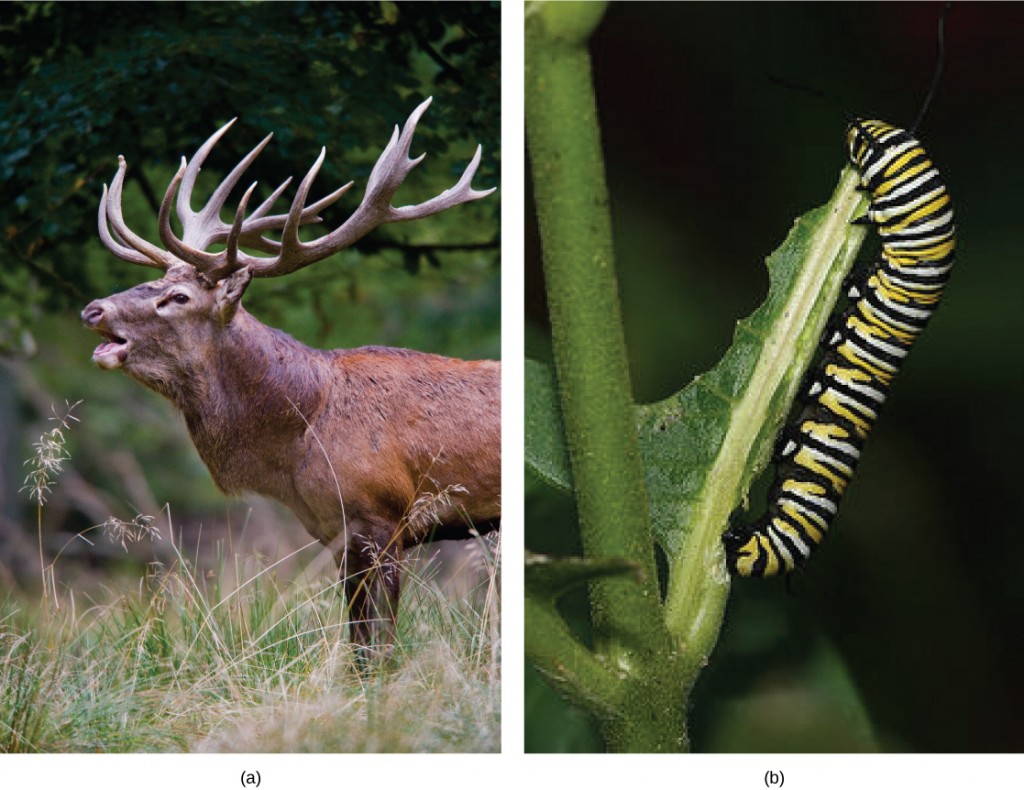
Carnivores are animals that eat other animals. The word carnivore is derived from Latin and literally means "meat eater." Wild cats such every bit lions, shown in Figure 35.three a and tigers are examples of vertebrate carnivores, every bit are snakes and sharks, while invertebrate carnivores include ocean stars, spiders, and ladybugs, shown in Figure 15.3 b . Obligate carnivores are those that rely entirely on beast flesh to obtain their nutrients; examples of obligate carnivores are members of the cat family, such as lions and cheetahs. Facultative carnivores are those that also eat non-creature nutrient in addition to animal nutrient. Note that there is no clear line that differentiates facultative carnivores from omnivores; dogs would be considered facultative carnivores.

Omnivores are animals that eat both constitute- and animal-derived nutrient. In Latin, omnivore means to eat everything. Humans, bears (shown in Figure xv.4 a ), and chickens are example of vertebrate omnivores; invertebrate omnivores include cockroaches and crayfish (shown in Effigy 15.4 b ).
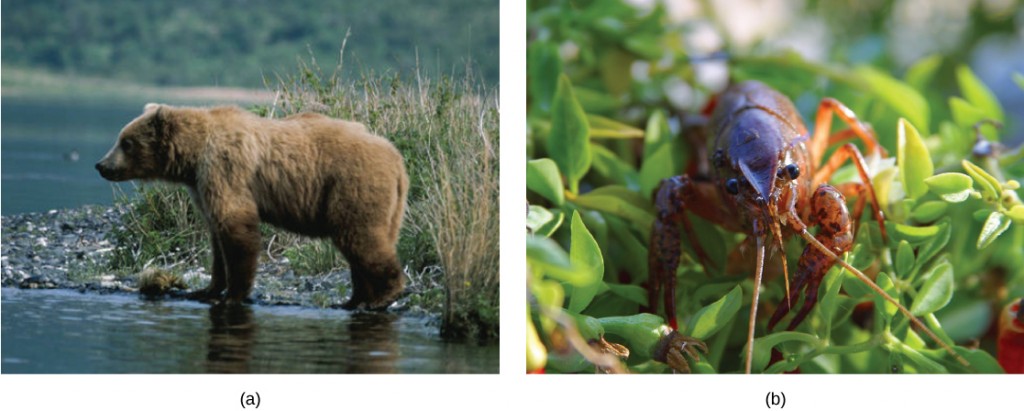
Invertebrate Digestive Systems
Animals have evolved unlike types of digestive systems to aid in the digestion of the different foods they eat. The simplest case is that of a gastrovascular cavity and is found in organisms with only ane opening for digestion. Platyhelminthes (flatworms), Ctenophora (comb jellies), and Cnidaria (coral, jelly fish, and sea anemones) use this type of digestion. Gastrovascular cavities, as shown in Figure 15.v a , are typically a bullheaded tube or cavity with only ane opening, the "oral fissure", which likewise serves equally an "anus". Ingested textile enters the mouth and passes through a hollow, tubular cavity. Cells within the cavity secrete digestive enzymes that pause down the food. The food particles are engulfed past the cells lining the gastrovascular crenel.
The comestible canal, shown in Figure 15.5 b , is a more avant-garde system: information technology consists of one tube with a oral cavity at ane end and an anus at the other. Earthworms are an case of an beast with an alimentary canal. Once the food is ingested through the mouth, it passes through the esophagus and is stored in an organ called the crop; and then information technology passes into the gizzard where it is churned and digested. From the gizzard, the food passes through the intestine, the nutrients are captivated, and the waste is eliminated as feces, called castings, through the anus.
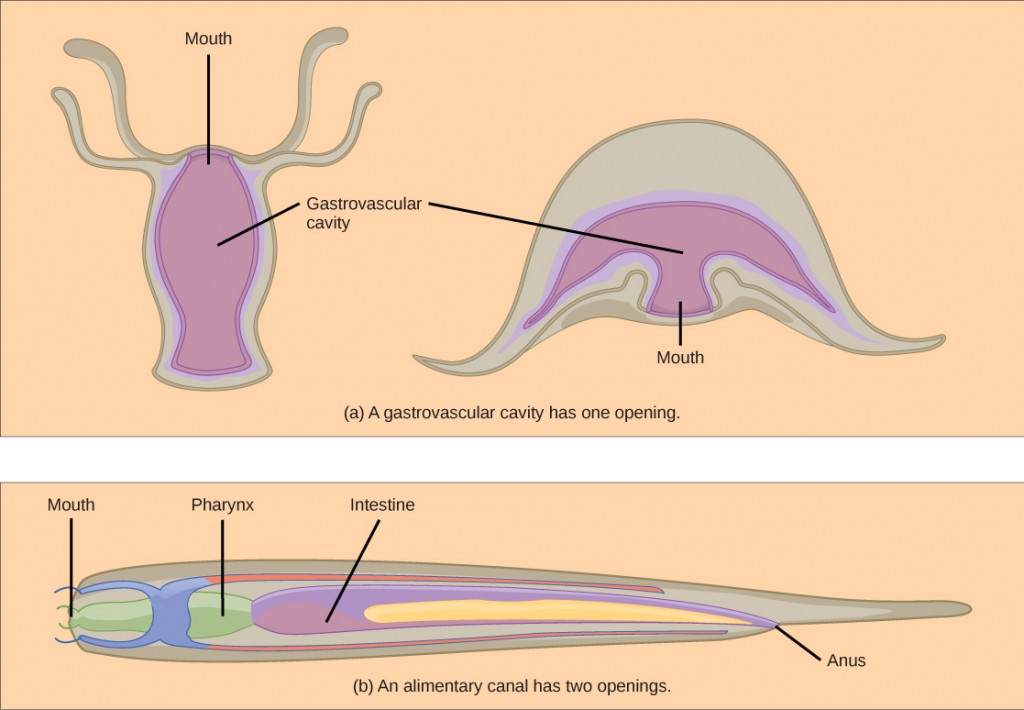
Vertebrate Digestive Systems
Vertebrates accept evolved more complex digestive systems to adapt to their dietary needs. Some animals accept a unmarried breadbasket, while others have multi-chambered stomachs. Birds accept developed a digestive system adapted to eating unmasticated food.
Monogastric: Single-chambered Tummy
Every bit the word monogastric suggests, this type of digestive arrangement consists of i ("mono") stomach chamber ("gastric"). Humans and many animals have a monogastric digestive system equally illustrated in Figure 15.vi ab . The procedure of digestion begins with the mouth and the intake of food. The teeth play an important role in masticating (chewing) or physically breaking down food into smaller particles. The enzymes present in saliva likewise brainstorm to chemically break downwardly food. The esophagus is a long tube that connects the oral fissure to the stomach. Using peristalsis, or wave-like smooth muscle contractions, the muscles of the esophagus button the food towards the stomach. In society to speed upwardly the actions of enzymes in the stomach, the stomach is an extremely acidic environment, with a pH between ane.5 and ii.five. The gastric juices, which include enzymes in the stomach, human activity on the food particles and proceed the process of digestion. Further breakup of nutrient takes place in the minor intestine where enzymes produced by the liver, the minor intestine, and the pancreas continue the process of digestion. The nutrients are absorbed into the blood stream across the epithelial cells lining the walls of the small intestines. The waste matter material travels on to the large intestine where water is captivated and the drier waste product is compacted into carrion; it is stored until it is excreted through the rectum.
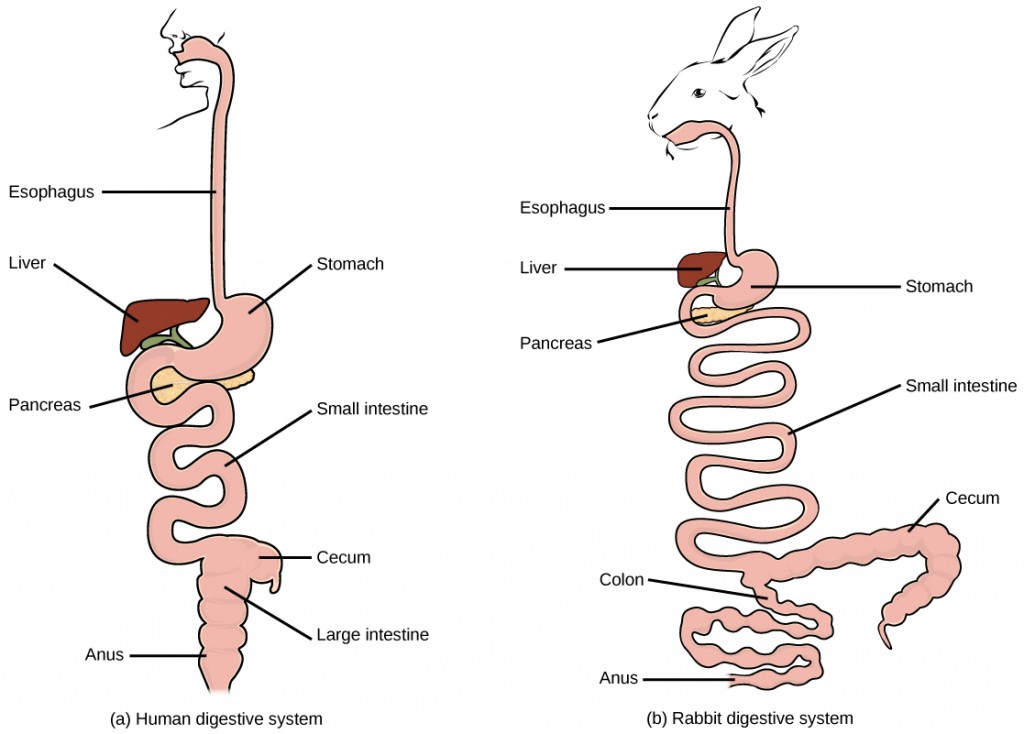
(a) Humans and herbivores, such as the (b) rabbit, have a monogastric digestive system. However, in the rabbit the pocket-size intestine and cecum are enlarged to let more time to digest plant textile. The enlarged organ provides more than surface area for absorption of nutrients. Rabbits digest their food twice: the offset time food passes through the digestive organisation, it collects in the cecum, and then it passes every bit soft carrion called cecotrophes. The rabbit re-ingests these cecotrophes to farther digest them.
Avian
Birds face special challenges when information technology comes to obtaining diet from food. They do not take teeth and so their digestive system, shown in Figure 15.7, must be able to process un-masticated food. Birds have evolved a variety of neb types that reflect the vast diverseness in their diet, ranging from seeds and insects to fruits and nuts. Because most birds wing, their metabolic rates are high in order to efficiently procedure food and go on their body weight low. The stomach of birds has two chambers: the proventriculus, where gastric juices are produced to assimilate the food before it enters the stomach, and the gizzard, where the food is stored, soaked, and mechanically basis. The undigested material forms nutrient pellets that are sometimes regurgitated. Most of the chemical digestion and absorption happens in the intestine and the waste is excreted through the cloaca.
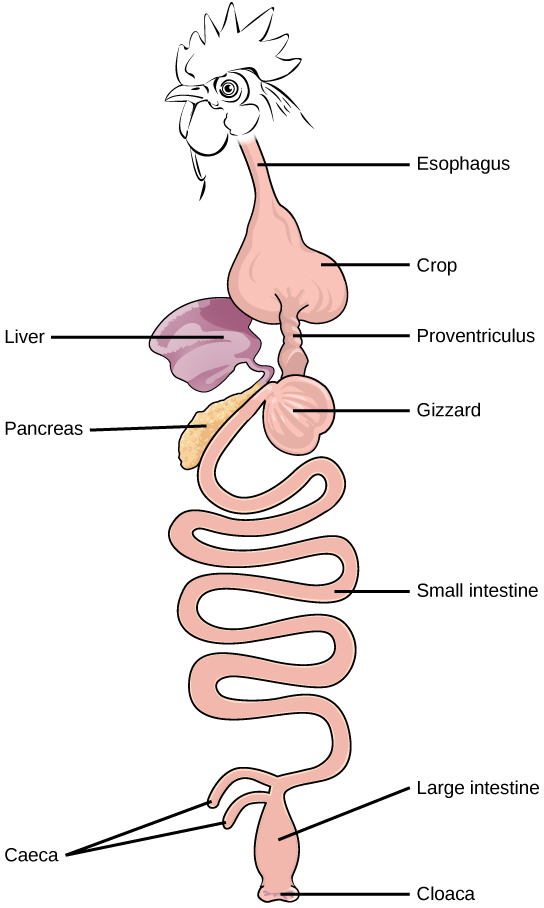
Parts of the Digestive System
The vertebrate digestive system is designed to facilitate the transformation of food matter into the nutrient components that sustain organisms.
Oral Crenel
The oral crenel, or rima oris, is the point of entry of nutrient into the digestive organisation, illustrated in Effigy 15.9. The food consumed is cleaved into smaller particles past mastication, the chewing activity of the teeth. All mammals accept teeth and can chew their food.
The all-encompassing chemical process of digestion begins in the mouth. Every bit food is being chewed, saliva, produced by the salivary glands, mixes with the food. Saliva is a watery substance produced in the mouths of many animals. There are three major glands that secrete saliva—the parotid, the submandibular, and the sublingual. Saliva contains fungus that moistens nutrient and buffers the pH of the food. Saliva likewise contains immunoglobulins and lysozymes, which have antibacterial activeness to reduce molar disuse past inhibiting growth of some bacteria. Saliva too contains an enzyme called salivary amylase that begins the process of converting starches in the food into a disaccharide called maltose. Another enzyme called lipase is produced by the cells in the tongue. Lipases are a course of enzymes that can break down triglycerides. The lingual lipase begins the breakup of fat components in the food. The chewing and wetting activity provided by the teeth and saliva prepare the food into a mass called the bolus for swallowing. The tongue helps in swallowing—moving the bolus from the oral fissure into the pharynx. The pharynx opens to two passageways: the trachea, which leads to the lungs, and the esophagus, which leads to the stomach. The trachea has an opening called the glottis, which is covered past a cartilaginous flap chosen the epiglottis. When swallowing, the epiglottis closes the glottis and food passes into the esophagus and not the trachea. This system allows food to exist kept out of the trachea.
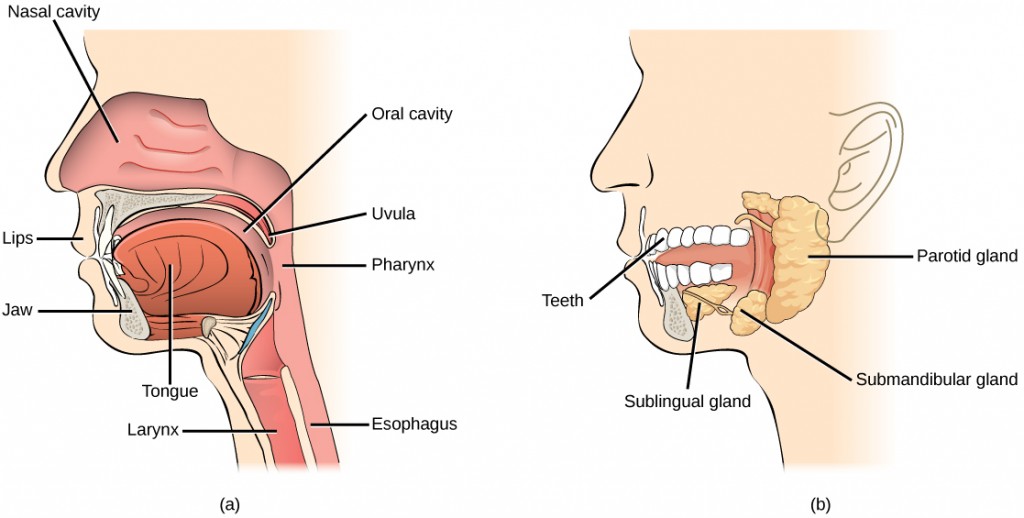
Digestion of nutrient begins in the (a) oral crenel. Food is masticated past teeth and moistened by saliva secreted from the (b) salivary glands. Enzymes in the saliva brainstorm to digest starches and fats. With the help of the tongue, the resulting bolus is moved into the esophagus past swallowing. (credit: modification of work by the National Cancer Institute)
Esophagus
The esophagus is a tubular organ that connects the mouth to the stomach. The chewed and softened nutrient passes through the esophagus afterward being swallowed. The smoothen muscles of the esophagus undergo a series of wave like movements chosen peristalsis that push the nutrient toward the tum, every bit illustrated in Figure fifteen.10. The peristalsis wave is unidirectional—information technology moves food from the mouth to the stomach, and reverse movement is not possible. The peristaltic move of the esophagus is an involuntary reflex; information technology takes place in response to the act of swallowing.
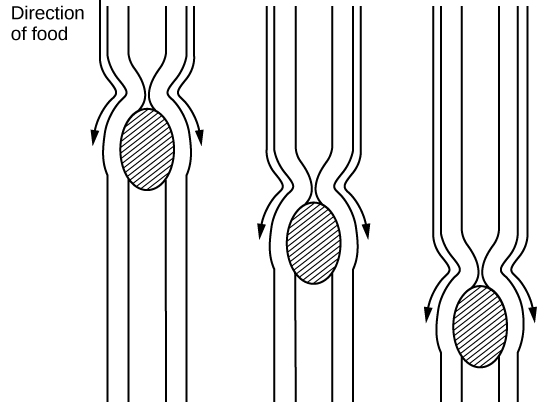
A band-like musculus called a sphincter forms valves in the digestive system. The gastro-esophageal sphincter is located at the tum finish of the esophagus. In response to swallowing and the pressure level exerted by the bolus of food, this sphincter opens, and the bolus enters the breadbasket. When there is no swallowing action, this sphincter is close and prevents the contents of the stomach from traveling up the esophagus. Many animals have a truthful sphincter; however, in humans, there is no truthful sphincter, but the esophagus remains closed when there is no swallowing action. Acid reflux or "heartburn" occurs when the acidic digestive juices escape into the esophagus.
Stomach
A large part of digestion occurs in the tummy, shown in Figure 15.eleven. The breadbasket is a saclike organ that secretes gastric digestive juices. The pH in the stomach is between i.v and two.5. This highly acidic environment is required for the chemical breakup of nutrient and the extraction of nutrients. When empty, the stomach is a rather small organ; however, it tin aggrandize to up to 20 times its resting size when filled with food. This characteristic is particularly useful for animals that need to swallow when nutrient is bachelor.
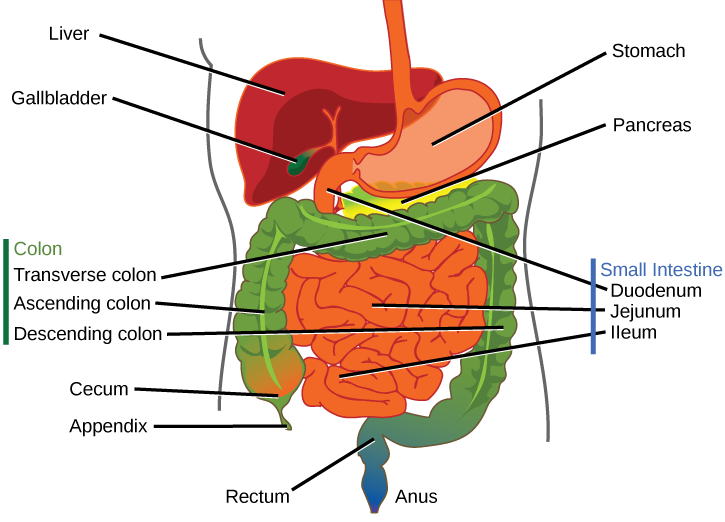
Which of the following statements virtually the digestive system is fake?
- Chyme is a mixture of food and digestive juices that is produced in the stomach.
- Food enters the big intestine earlier the small intestine.
- In the small intestine, chyme mixes with bile, which emulsifies fats.
- The stomach is separated from the small intestine past the pyloric sphincter.
The stomach is as well the major site for protein digestion in animals other than ruminants. Protein digestion is mediated by an enzyme chosen pepsin in the stomach chamber. Pepsin is secreted by the master cells in the stomach in an inactive form chosen pepsinogen. Pepsin breaks peptide bonds and cleaves proteins into smaller polypeptides; it as well helps actuate more than pepsinogen, starting a positive feedback mechanism that generates more than pepsin. Some other cell type—parietal cells—secrete hydrogen and chloride ions, which combine in the lumen to course hydrochloric acid, the primary acidic component of the tum juices. Muriatic acid helps to convert the inactive pepsinogen to pepsin. The highly acidic surroundings likewise kills many microorganisms in the nutrient and, combined with the action of the enzyme pepsin, results in the hydrolysis of protein in the food. Chemical digestion is facilitated past the churning activeness of the stomach. Contraction and relaxation of smooth muscles mixes the stomach contents near every xx minutes. The partially digested food and gastric juice mixture is called chyme. Chyme passes from the stomach to the small intestine. Further poly peptide digestion takes place in the small-scale intestine. Gastric elimination occurs within two to half dozen hours subsequently a meal. Merely a modest corporeality of chyme is released into the small intestine at a time. The movement of chyme from the breadbasket into the small intestine is regulated past the pyloric sphincter.
When digesting protein and some fats, the stomach lining must be protected from getting digested by pepsin. There are two points to consider when describing how the stomach lining is protected. First, as previously mentioned, the enzyme pepsin is synthesized in the inactive form. This protects the master cells, because pepsinogen does not accept the same enzyme functionality of pepsin. Second, the stomach has a thick fungus lining that protects the underlying tissue from the action of the digestive juices. When this fungus lining is ruptured, ulcers tin can grade in the stomach. Ulcers are open wounds in or on an organ caused by bacteria (Helicobacter pylori) when the mucus lining is ruptured and fails to reform.
Small Intestine
Chyme moves from the tummy to the small intestine. The pocket-size intestine is the organ where the digestion of poly peptide, fats, and carbohydrates is completed. The small intestine is a long tube-like organ with a highly folded surface containing finger-like projections called the villi. The apical surface of each villus has many microscopic projections called microvilli. These structures, illustrated in Figure 15.12, are lined with epithelial cells on the luminal side and allow for the nutrients to be absorbed from the digested nutrient and captivated into the blood stream on the other side. The villi and microvilli, with their many folds, increase the surface area of the intestine and increment absorption efficiency of the nutrients. Absorbed nutrients in the blood are carried into the hepatic portal vein, which leads to the liver. There, the liver regulates the distribution of nutrients to the rest of the body and removes toxic substances, including drugs, alcohol, and some pathogens.
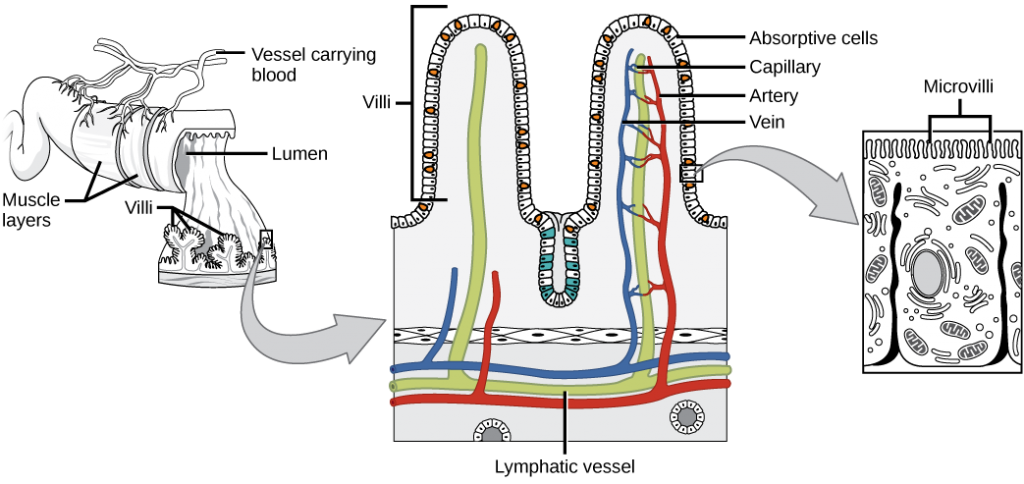
Which of the following statements about the small intestine is simulated?
- Absorptive cells that line the small intestine have microvilli, small projections that increment surface area and aid in the absorption of food.
- The inside of the small intestine has many folds, called villi.
- Microvilli are lined with blood vessels also as lymphatic vessels.
- The within of the small intestine is called the lumen.
The human being small intestine is over 6m long and is divided into three parts: the duodenum, the jejunum, and the ileum. The "C-shaped," fixed office of the small intestine is called the duodenum and is shown in Figure 15.11. The duodenum is separated from the stomach by the pyloric sphincter which opens to allow chyme to motion from the stomach to the duodenum. In the duodenum, chyme is mixed with pancreatic juices in an alkali metal solution rich in bicarbonate that neutralizes the acidity of chyme and acts as a buffer. Pancreatic juices as well contain several digestive enzymes. Digestive juices from the pancreas, liver, and gallbladder, as well as from gland cells of the intestinal wall itself, enter the duodenum. Bile is produced in the liver and stored and concentrated in the gallbladder. Bile contains bile salts which emulsify lipids while the pancreas produces enzymes that catabolize starches, disaccharides, proteins, and fats. These digestive juices break down the food particles in the chyme into glucose, triglycerides, and amino acids. Some chemical digestion of food takes place in the duodenum. Absorption of fat acids too takes place in the duodenum.
The 2nd part of the small intestine is called the jejunum, shown in Effigy 15.xi. Here, hydrolysis of nutrients is connected while most of the carbohydrates and amino acids are absorbed through the abdominal lining. The bulk of chemical digestion and nutrient absorption occurs in the jejunum.
The ileum, also illustrated in Figure fifteen.xi is the last part of the small intestine and hither the bile salts and vitamins are captivated into blood stream. The undigested food is sent to the colon from the ileum via peristaltic movements of the musculus. The ileum ends and the big intestine begins at the ileocecal valve. The vermiform, "worm-like," appendix is located at the ileocecal valve. The appendix of humans secretes no enzymes and has an insignificant role in immunity.
Big Intestine
The big intestine, illustrated in Figure fifteen.13, reabsorbs the water from the undigested food fabric and processes the waste material material. The human being large intestine is much smaller in length compared to the pocket-sized intestine only larger in diameter. Information technology has three parts: the cecum, the colon, and the rectum. The cecum joins the ileum to the colon and is the receiving pouch for the waste matter thing. The colon is home to many bacteria or "intestinal flora" that assist in the digestive processes. The colon tin can be divided into iv regions, the ascending colon, the transverse colon, the descending colon and the sigmoid colon. The main functions of the colon are to extract the water and mineral salts from undigested food, and to store waste cloth. Carnivorous mammals accept a shorter large intestine compared to herbivorous mammals due to their diet.
Rectum and Anus
The rectum is the concluding stop of the large intestine, as shown in Effigy 15.xiii. The primary part of the rectum is to store the feces until defecation. The carrion are propelled using peristaltic movements during elimination. The anus is an opening at the far-end of the digestive tract and is the exit point for the waste material. Two sphincters between the rectum and anus control elimination: the inner sphincter is involuntary and the outer sphincter is voluntary.
Accessory Organs
The organs discussed in a higher place are the organs of the digestive tract through which food passes. Accessory organs are organs that add secretions (enzymes) that catabolize nutrient into nutrients. Accessory organs include salivary glands, the liver, the pancreas, and the gallbladder. The liver, pancreas, and gallbladder are regulated by hormones in response to the food consumed.
The liver is the largest internal organ in humans and it plays a very of import role in digestion of fats and detoxifying blood. The liver produces bile, a digestive juice that is required for the breakdown of fatty components of the food in the duodenum. The liver also processes the vitamins and fats and synthesizes many plasma proteins.
The pancreas is another important gland that secretes digestive juices. The chyme produced from the stomach is highly acidic in nature; the pancreatic juices contain high levels of bicarbonate, an alkali that neutralizes the acidic chyme. Additionally, the pancreatic juices incorporate a large multifariousness of enzymes that are required for the digestion of protein and carbohydrates.
The gallbladder is a small organ that aids the liver by storing bile and concentrating bile salts. When chyme containing fatty acids enters the duodenum, the bile is secreted from the gallbladder into the duodenum.
Summary
Dissimilar animals take evolved dissimilar types of digestive systems specialized to meet their dietary needs. Humans and many other animals take monogastric digestive systems with a single-chambered tummy. Birds have evolved a digestive system that includes a gizzard where the nutrient is crushed into smaller pieces. This compensates for their inability to masticate. Ruminants that consume large amounts of establish material have a multi-chambered stomach that digests roughage. Pseudo-ruminants accept similar digestive processes equally ruminants but do non accept the four-compartment stomach. Processing food involves ingestion (eating), digestion (mechanical and enzymatic breakdown of large molecules), absorption (cellular uptake of nutrients), and emptying (removal of undigested waste as feces).
Many organs work together to digest food and absorb nutrients. The oral cavity is the point of ingestion and the location where both mechanical and chemical breakdown of nutrient begins. Saliva contains an enzyme called amylase that breaks down carbohydrates. The food bolus travels through the esophagus by peristaltic movements to the stomach. The stomach has an extremely acidic environment. An enzyme chosen pepsin digests poly peptide in the stomach. Further digestion and absorption have place in the minor intestine. The big intestine reabsorbs water from the undigested food and stores waste until elimination.
Exercises
- Which of the following statements most the digestive system is false?
- Chyme is a mixture of food and digestive juices that is produced in the tummy.
- Food enters the large intestine before the small intestine.
- In the pocket-size intestine, chyme mixes with bile, which emulsifies fats.
- The tummy is separated from the small intestine by the pyloric sphincter.
- Which of the following statements about the small intestine is imitation?
- Absorbent cells that line the small intestine have microvilli, pocket-size projections that increase surface area and aid in the absorption of food.
- The inside of the pocket-size intestine has many folds, called villi.
- Microvilli are lined with blood vessels as well as lymphatic vessels.
- The inside of the small intestine is chosen the lumen.
- Which of the following is a pseudo-ruminant?
- cow
- pig
- crow
- equus caballus
- Which of the following statements is untrue?
- Roughage takes a long time to digest.
- Birds swallow large quantities at ane fourth dimension and so that they tin wing long distances.
- Cows do non accept upper teeth.
- In pseudo-ruminants, roughage is digested in the cecum.
- The acidic nature of chyme is neutralized by ________.
- potassium hydroxide
- sodium hydroxide
- bicarbonates
- vinegar
- The digestive juices from the liver are delivered to the ________.
- breadbasket
- liver
- duodenum
- colon
- How does the polygastric digestive system aid in digesting roughage?
- How do birds digest their food in the absence of teeth?
- What is the role of the accompaniment organs in digestion?
- Explain how the villi and microvilli aid in assimilation.
Answers
- B
- C
- D
- B
- C
- C
- Animals with a polygastric digestive arrangement take a multi-chambered tummy. The iv compartments of the stomach are chosen the rumen, reticulum, omasum, and abomasum. These chambers comprise many microbes that break down the cellulose and ferment the ingested nutrient. The abomasum is the "true" stomach and is the equivalent of a monogastric stomach sleeping room where gastric juices are secreted. The four-compartment gastric chamber provides larger space and the microbial back up necessary for ruminants to digest plant material.
- Birds have a tummy chamber called a gizzard. Hither, the food is stored, soaked, and ground into finer particles, oft using pebbles. Once this process is complete, the digestive juices accept over in the proventriculus and continue the digestive process.
- Accessory organs play an important function in producing and delivering digestive juices to the intestine during digestion and absorption. Specifically, the salivary glands, liver, pancreas, and gallbladder play important roles. Malfunction of any of these organs can atomic number 82 to disease states.
- The villi and microvilli are folds on the surface of the small intestine. These folds increase the surface expanse of the intestine and provide more area for the assimilation of nutrients.
Glossary
alimentary canal: tubular digestive system with a mouth and anus
anus: go out indicate for waste material
bile: digestive juice produced by the liver; important for digestion of lipids
bolus: mass of food resulting from chewing action and wetting by saliva
carnivore: animal that consumes fauna mankind
chyme: mixture of partially digested food and stomach juices
digestion: mechanical and chemical interruption down of food into small organic fragments
duodenum: first part of the small-scale intestine where a large part of digestion of carbohydrates and fats occurs
endocrine system: system that controls the response of the various glands in the body and the release of hormones at the appropriate times
esophagus: tubular organ that connects the mouth to the stomach
essential nutrient: food that cannot be synthesized by the body; it must be obtained from food
gallbladder: organ that stores and concentrates bile
gastric inhibitory peptide: hormone secreted past the small intestine in the presence of fatty acids and sugars; it also inhibits acid production and peristalsis in order to slow down the rate at which food enters the small intestine
gastrin: hormone which stimulates muriatic acid secretion in the stomach
gastrovascular crenel: digestive organisation consisting of a single opening
gizzard: muscular organ that grinds food
herbivore: creature that consumes strictly found diet
ileum: last role of the small-scale intestine; connects the small intestine to the large intestine; important for absorption of B-12
ingestion: act of taking in nutrient
jejunum: 2d part of the small intestine
lactase: enzyme that breaks down lactose into glucose and galactose
big intestine: digestive system organ that reabsorbs h2o from undigested textile and processes waste matter
lipase: enzyme that chemically breaks down lipids
liver: organ that produces bile for digestion and processes vitamins and lipids
maltase: enzyme that breaks downwards maltose into glucose
mineral: inorganic, elemental molecule that carries out important roles in the torso
monogastric: digestive system that consists of a single-chambered tum
omnivore: animal that consumes both plants and animals
pancreas: gland that secretes digestive juices
pepsinogen: inactive course of pepsin
pepsin: enzyme found in the stomach whose main role is protein digestion
peristalsis: wave-like movements of muscle tissue
proventriculus: glandular role of a bird's tummy
rectum: expanse of the body where feces is stored until elimination
roughage: component of food that is low in free energy and high in fiber
ruminant: animal with a tum divided into four compartments
salivary amylase: enzyme found in saliva, which converts carbohydrates to maltose
small intestine: organ where digestion of protein, fats, and carbohydrates is completed
somatostatin: hormone released to stop acid secretion when the stomach is empty
sphincter: band of muscle that controls movement of materials throughout the digestive tract
tummy: saclike organ containing acidic digestive juices
villi: folds on the inner surface of the pocket-size intestine whose role is to increment absorption surface area
vitamin: organic substance necessary in modest amounts to sustain life
Source: https://opentextbc.ca/biology/chapter/15-1-digestive-systems/
Posted by: pendletonexagagaidid.blogspot.com

0 Response to "Which Of The Following Describes An Animal That Consumes Primarily Plant Tissues?"
Post a Comment